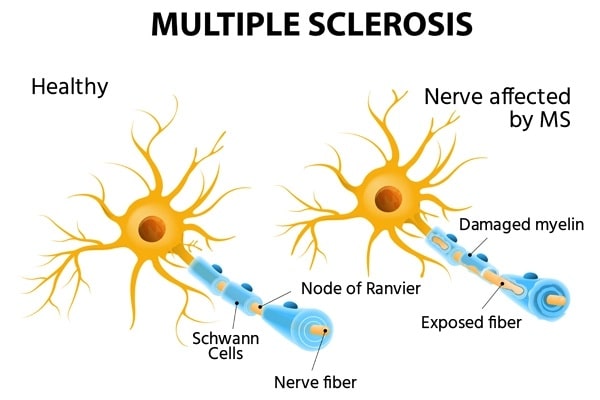Multiple Sclerosis
Multiple sclerosis is an autoimmune disease that can potentially paralyze the brain and spinal cord or central nervous system. In this disease, the immune system attacks itself, causing communication problems between the brain and the rest of the body. Ultimately, this disease can cause permanent damage or nerve damage.
Signs and symptoms of the condition vary widely and depend on the amount of nerve damage and which nerves are affected. Some people with severe cases may lose the ability to walk independently. Others may experience a reduction in old symptoms without any new symptoms.
Symptoms of Multiple Sclerosis
The signs and symptoms of multiple sclerosis may vary from person to person. This depends on the location of the affected nerve fibers. Symptoms that often affect movement include:
- Numbness or weakness in one or more limbs, usually occurring on one side of the body at a time.
- An electric shock sensation that occurs with certain neck movements. Especially when bending the neck forward.
- Tremors, lack of coordination or unsteady gait.
Vision problems are also common, including:
- Partial or complete loss of vision. Usually in one eye at a time. Often accompanied by pain on eye movement.
- Prolonged double vision.
- Blurred vision.
Symptoms of multiple sclerosis can also include:
- Slurred speech.
- Fatigue.
- Dizzy.
- Tingling or pain in parts of the body.
- Tingling or pain in parts of the body.
- Problems with sexual, bowel, and bladder function.
Multiple Sclerosis Risk Factors
These factors can increase a person’s risk of developing multiple sclerosis:
- Age. The disease can occur at any age, but onset usually occurs around 20 to 40 years of age.
- Gender. Women are two to three times more at risk than men.
- Family history. If a parent or sibling has multiple sclerosis, you are at higher risk of developing the disease.
- Certain infections. Several viruses have been linked to multiple sclerosis.
- Vitamin D. Having low vitamin D levels and low sun exposure are associated with a greater risk of multiple sclerosis.
- Certain autoimmune diseases.
- Smoke.
Causes of Multiple Sclerosis
The cause of multiple sclerosis is not fully understood. It is thought to be an autoimmune disease, which is when the body’s immune system attacks its own tissues. In multiple sclerosis, this immune system damage destroys the fatty substance that coats and protects nerve fibers in the brain and spinal cord (myelin).
Myelin can be likened to the insulating layer of nerves. When myelin is damaged and nerve fibers are exposed, messages traveling along the nerve fibers can be slowed or blocked. It is not known exactly why multiple sclerosis develops in some people. Genetic and environmental factors are thought to play a role.
There are four types of multiple sclerosis:
-
Clinically isolated syndrome
This condition is a single first episode, with symptoms lasting at least 24 hours. If another episode occurs later, your doctor may diagnose relapsing-remitting multiple sclerosis.
-
Relapsing-Remitting MS (RRMS)
This is the most common type of multiple sclerosis. About 85 percent of people with this condition are initially diagnosed with RRMS. The condition involves episodes of new or worsening symptoms, followed by periods of remission (partial or complete disappearance of symptoms).
-
Primary Progressive Multiple Sclerosis
Symptoms worsen progressively, without early relapses or remissions. Some people may experience periods of stability and periods when symptoms get worse and then better. About 15 percent of people with multiple sclerosis have this type.
-
Secondary Progressive Multiple Sclerosis
Initially, a person will experience episodes of relapse and temporary improvement, but then the disease will begin to progress quite severely.
Multiple Sclerosis Diagnosis
The doctor will perform a physical and neurological examination as an initial diagnosis. No single examination can confirm the diagnosis, so the doctor will use several examinations. The examinations include:
- MRI of the brain and spinal cord.
- Spinal fluid analysis, which can identify antibodies indicating previous infection.
- Another test that can measure electrical activity in response to stimulation.
A person may need more tests at a later date to check for further changes.
Multiple Sclerosis Treatment
There is currently no cure for multiple sclerosis. Treatment focuses on managing symptoms, reducing relapses, and slowing the progression of the disease. A comprehensive treatment plan may include:
-
Therapy
Some long-term medications are given to reduce relapses. Drug therapy can slow the progression of the disease and prevent new ones from forming in the brain and spinal cord.
-
Relapse management
If someone has a severe attack, a neurologist will recommend high doses of corticosteroids. The drugs can quickly reduce inflammation and slow the damage to myelin.
-
Physical rehabilitation.
Multiple sclerosis can affect physical function. Staying physically fit and strong will help maintain mobility.
-
Mental health counseling
Coping with a chronic condition can be challenging and affect mood and memory. Getting emotional support is an important part of managing the disease.
Multiple Sclerosis Complications
People with multiple sclerosis can also experience complications:
- Muscle stiffness or spasms.
- Paralysis, usually in the legs.
- Problems with bladder, bowel, or sexual function.
- Mental changes, such as forgetfulness or mood swings.
- Depression.
- Epilepsy.
Multiple Sclerosis Prevention
Lifestyle changes can prevent and improve the condition of sufferers. For example by:
- Eat healthy foods.
- Exercise regularly.
- Managing stress.
- Do not smoke and limit alcohol intake.

